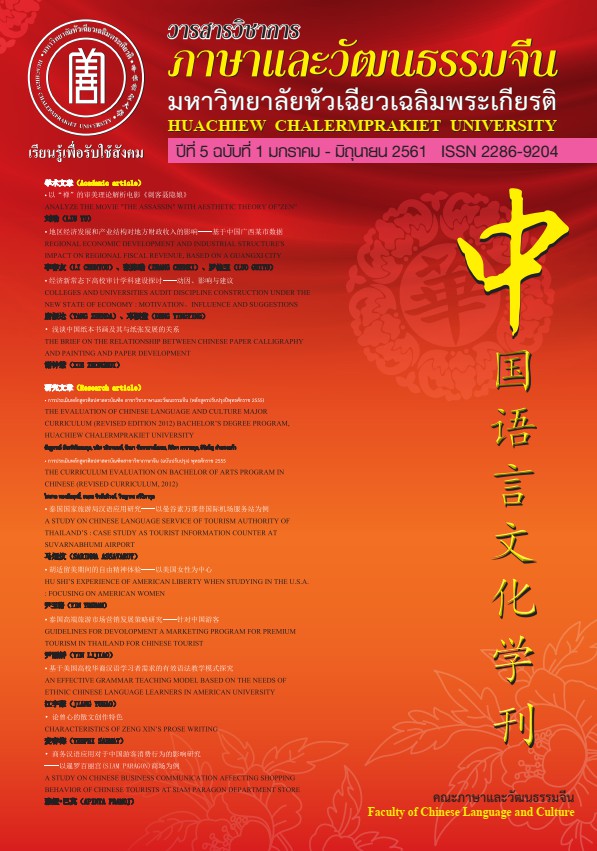THE EVALUATION OF CHINESE LANGUAGE AND CULTURE MAJOR CURRICULUM (REVISED EDITION 2012) BACHELOR’S DEGREE PROGRAM, HUACHIEW CHALERMPRAKIET UNIVERSITY
Keywords:
Curriculum Evaluation, Chinese Language and Culture Major, Bachelor’s Degree Program, Huachiew Chalermprakiet UniversityAbstract
The purpose of this study was to evaluate the Chinese Language and Culture Major Curriculum (Revised Edition, Academic Year 2012). The evaluation focused on 4 aspects including the objectives of the curriculum, the structure and content of the curriculum, the curriculum management, and the characteristics of the graduates. There were 113 participants in this study; 5 instructors, 99 students in the third-year and fourth-year groups, 7 graduates, and 2 employers. Data Analysis was based on questionnaires. The data was analyzed in terms of frequency, percentage, and the differences of mean groups. The results of this research were as follows; Input : This section was divided into 3 parts ; 1) Qualification of the program instructors It was found that the instructors were satisfied with the qualifications and experience of the program instructors which was rated with the highest average scores. The students were satisfied with this aspect which was rated with the high average scores. The graduates were satisfied with the instructors’ qualifications and the courses they were assigned to teach which were rated with the highest average scores. 2) Characteristics of the students All of the instructors took part in the admission process to interview the new students of the program. 3) Educational equipment The instructors were satisfied with the well-equipped classrooms which were rated with the high average scores. The students and graduates were satisfied with HCU Library Information Section which was rated with the highest average scores. Process: This section was divided into 3 parts. 1) Curriculum Management The students and the graduates were satisfied with the curriculum management which was rated with the high and the highest average scores respectively. 2) Teaching and Learning Process The instructors and students were satisfied with the teaching and learning process. Furthermore, the instructors and students were satisfied with the use of teaching materials with the teaching and learning process which was rated with the highest average scores. 3) Evaluation Methods The instructors and students were satisfied with the evaluation methods which were precise and systematic and were rated with the high average scores and the highest average scores. Learning Outcome Standards 1) The Characteristics of the Graduates The instructors and students were satisfied with the language skills in terms of the use of language, speaking, listening, reading and writing skills which was rated with the moderate average scores, whereas the graduates were satisfied with their language skills and the employers were also satisfied with the graduates’ language skills which were rated with the highest average 2) The characteristics of the Graduates in accordance with Thailand qualification Framework (TQF) The employers were satisfied with the five aspects of learning outcome standards.scores.
References
จิรศักดิ์ สุรังคพิพรรธน์. (2540) การพัฒนาแบบการประเมินหลักสูตรระดับปริญญาตรี สถาบันเทคโนโลยีราชมงคล. วิทยานิพนธ์ปริญญาโท. กรุงเทพฯ : จุฬาลงกรณ์มหาวิทยาลัย.
ใจทิพย์ เอื้อรัจนพงศ์. (2539) การพัฒนาหลักสูตร หลักการและแนวปฎิบัติ. กรุงเทพฯ : โรงพิมพ์อลีน เพรส.
บุญชม ศรีสะอาด. (2546) การพัฒนาหลักสูตรและการวิจัยเกี่ยวกับหลักสูตร. กรุงเทพฯ : สุวีรยาสาส์น.
บุญเลี้ยง ทุมทอง. (2553) การพัฒนาหลักสูตร. กรุงเทพฯ : สำนักพิมพ์แห่งจุฬาลงกรณ์มหาวิทยาลัย.
พศิน แตงจวง. (2557) จิตวิทยาประยุกต์ในการศึกษานอกระบบ(ฉบับปรับปรุง). กรุงเทพฯ : ภาควิชาส่งเสริมการศึกษามหาวิทยาลัยเชียงใหม่.
วิชัย วงษ์ใหญ่. (2537) กระบวนการพัฒนาหลักสูตรและการเรียนการสอนภาคปฏิบัติ. กรุงเทพฯ : สุวีริยาสาส์น.
ศิริชัย กาญจนวาสี. (2552) ทฤษฎีการประเมิน. (พิมพ์ครั้งที่ 7) กรุงเทพฯ : สำนักพิมพ์แห่งจุฬาลงกรณ์มหาวิทยาลัย.
อุไรพรรณ เจนวาณิชยานนท์และคณะ. (2546) การประเมินหลักสูตรหมวดวิชาศึกษาทั่วไป. สำนักพิมพ์มหาวิทยาลัยหัวเฉียวเฉลิมพระเกียรติ
Downloads
Published
How to Cite
Issue
Section
License
บทความที่ได้รับการตีพิมพ์เป็นลิขสิทธิ์ของวารสารภาษาและวัฒนธรรมจีน มหาวิทยาลัยหัวเฉียวเฉลิมพระเกียรติ
บทความใน “วารสารวิชาการภาษาและวัฒนธรรมจีน” เป็นทรรศนะของผู้เขียนโดยเฉพาะ กองบรรณาธิการไม่มีส่วนในความคิดเห็นในข้อเขียนเหล่านั้น




